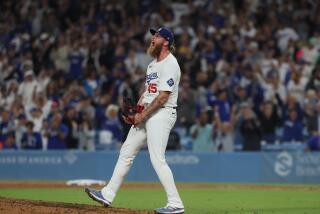Injuries to Stephen Strasburg, Mike Leake are unlikely to slow climb of top pitching prospects
- Share via
Cincinnati Reds pitcher Mike Leake has spent more time on the major league disabled list than he has on a minor league roster. By the end of the season, the Washington Nationals’ Stephen Strasburg will be able to say almost the same thing.
For those who believe such young arms are both as precious and as fragile as a Ming vase, the two cases offer more than enough evidence to prove that big league general managers have lost their minds.
There is a contrary view, however, one to which Angels pitching coach Mike Butcher subscribes. That view says Leake and Strasburg were in the majors so quickly because they were ready, not because they were rushed. And their recent injuries — Leake is out until at least the middle of the week because of a fatigued shoulder while Strasburg is out at least a year after having Tommy John surgery Friday — really don’t change that.
“Both guys were pretty polished college pitchers,” Butcher said. “Both have gone out there and done a nice job. There has to be need at the major league level to have those guys move up that quickly.
“It’s all about time and the need of the major league club.”
Some clubs have more need than others, which is why Leake went directly from Arizona State to the Reds’ starting rotation and Strasburg started only 11 games in the minors before he was called up. It is also why the Reds, four days after putting the 22-year-old Leake on the disabled list, promoted 22-year-old Aroldis Chapman, who had pitched fewer than 96 innings in the minors.
Yet Cincinnati is hardly the only team relying on young arms. In fact, this season’s crop of dominant — and durable — young pitchers might be the best in more than a generation.
Entering the weekend, five of the top 10 pitchers in wins, seven of the top 10 in earned-run average and seven of the top 12 in strikeouts were no older than 26. And 12 of the 13 teams still nursing at least an outside shot at the playoffs have received major contributions from at least one pitcher 26 or younger.
Among those is 22-year-old Mat Latos, who leads the San Diego Padres in both wins (13) and ERA (a league-best 2.25), 22-year-old Trevor Cahill, who leads the Oakland Athletics in wins (14) and ERA (2.82) and 22-year-old Neftali Feliz, who leads the Texas Rangers with 34 saves.
And where would the Tampa Bay Rays be without 25-year-old David Price and his 16 wins? Or the St. Louis Cardinals without 24-year Jaime Garcia, who is 12-6 with a 2.33 ERA? Even the veteran New York Yankees have embraced the youth movement, getting 16 wins from 24-year-old Phil Hughes.
Then there’s the San Francisco Giants’ Tim Lincecum, who won two Cy Young awards before his 26th birthday.
Lincecum pitched all of 62 innings in the minors. Latos pitched 184. Combine that with the brief minor league stays of Strasburg, Leake and Chapman and you have the makings of a trend.
Cincinnati pitching coach Bryan Price isn’t sure he’s buying that, though.
“I don’t know,” he said. “I’d have no idea knowing that.”
In the case of Leake, Price said, the Reds had a spot in their rotation and Leake was the best guy they had to fill it.
“He’s so polished. He’s head and shoulders above most 22-year-olds as far as how he holds runners, fields his position, how he competes, command of all of his pitches,” Price said. “There wasn’t really a whole lot of rough edges that we needed to smooth out. He just went out and took the job.”
That isn’t to say minor league seasoning is unnecessary. Dodgers pitcher Chad Billingsley spent parts of four seasons in the minors and still made it to the majors by 21 and to the All-Star game before he turned 25. He says his minor league experience was a big reason for that success.
“When I got into the minor leagues, I was kind of learning my body. Getting it on a five-day routine and [learning] what it takes to get me ready for the next time,” he said. “The biggest thing was kind of preparing yourself to make 30-plus starts a year and throw 180, 200-plus innings.”
Butcher agrees. The minor leagues are there for a reason, and the pitcher who bypasses them is still the exception, not the rule — even if the major leagues appear to be filled with exceptions this season.
“It takes a special pitcher to make those jumps,” he said. “There has to be need at the major league level to have those guys move up that quickly.”
Still, Leake’s tired shoulder and Strasburg’s injured elbow might lead teams to think twice about continuing to promote young pitchers quickly, no matter how talented. But should it? After all, veteran pitchers get hurt too. The Boston Red Sox have lost Daisuke Matsuzaka, Josh Beckett and Hideki Okajima for significant time to injuries this season, and the oldest member of Oakland’s rotation, Ben Sheets, hasn’t pitched since the day after his 32nd birthday in July.
Reds Manager Dusty Baker, addressing Leake’s case specifically, says it’s more about winning than the number of candles on your birthday cake or paying your dues on bus rides through the minors.
“No, I don’t wish he went to the minor leagues,” Baker said of Leake, who won seven of his first eight decisions. “If he went to the minor leagues, we wouldn’t be in first place. Where would you rather learn how to deal with that? In the minor leagues or the big leagues?”
Times staff writer Ben Bolch contributed to this report.
More to Read
Go beyond the scoreboard
Get the latest on L.A.'s teams in the daily Sports Report newsletter.
You may occasionally receive promotional content from the Los Angeles Times.







